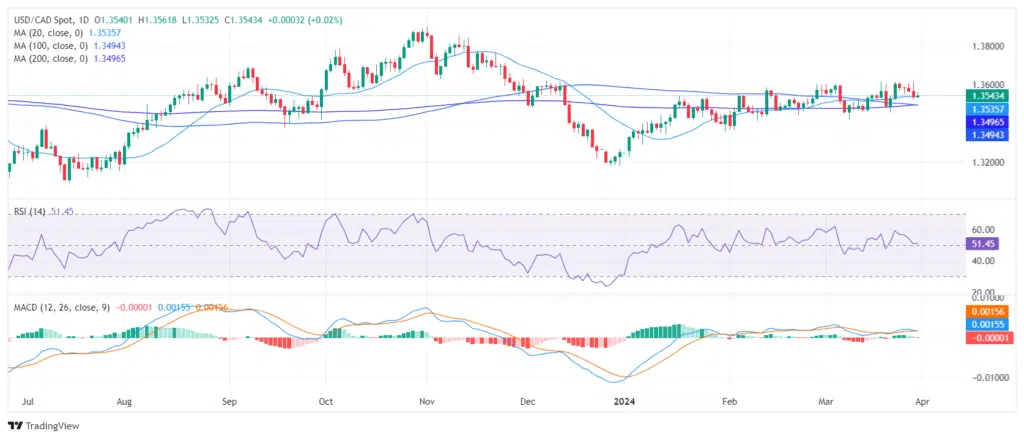- The PCE figures for February in the US, a crucial indicator of inflation, were largely in line with expectations. This data sets the stage for the market’s expectations and can significantly influence future Federal Reserve policy decisions.
- In the upcoming week, all eyes will be on the nonfarm payrolls, a key indicator of economic health. Market participants will be closely watching these figures as they make predictions regarding future decisions of the Federal Reserve, particularly in relation to interest rate expectations.
- The current data, particularly the PCE figures, may provide a valid reason for market participants to consider delaying any reductions in policy rates after June. This potential delay could significantly impact future Federal Reserve policy decisions.
Following a high of 1.3560 earlier in the trading session, the USD/CAD pair is currently trading around the 1.3543 mark on Friday. This indicates that the pair is showing slight declines during the session.
While investors analyze the most recent data on personal consumption expenditures (PCE), the market shifts its attention to upcoming employment figures. These figures have the potential to provide additional insight into the position that the Federal Reserve takes regarding the possibility of a delay in policy rates.
There was a slight increase in the PCE Price Index, which is preferred by the Federal Reserve as a method of measuring inflation in the United States, to 2.5% on an annual basis in February, compared to the 2.4% that was recorded in January. This was in line with the predictions that were made.
The increase for the month was 0.3%, which was slightly lower than the 0.4% that was predicted. Additionally, the Core PCE, which does not include food and energy, increased by 2.8% on an annual basis, which was in line with expectations, and it increased by 0.3% on a monthly basis throughout the year.
According to the revised core PCE data for January, there is a persistent pattern of inflation, which may prompt the Federal Reserve to consider maintaining interest rates at a higher level.
The upcoming data will play a significant role in shaping future policy choices, and the state of the job market may have the potential to influence the timing of rate reductions as well as the extent of those reductions. The robust employment data may prompt policymakers at the Federal Reserve to consider delaying interest rate reductions beyond June and possibly reducing the number of cuts that are projected to occur in 2024 from three to two.
Consequently, this could lend support to the United States Dollar. It is currently believed that there will be three instances of interest rate reductions in 2024, beginning in June. This is the most likely situation.
The Technical Analysis of the USD/CAD
Looking at the daily chart, the USD/CAD pair seems to be continuing to follow a relatively consistent trend.

It is generally observed that the Relative Strength Index (RSI) remains within the positive range, which indicates that there is a slight tendency in the market to be influenced by buying pressure.
Despite this, the MACD histogram displayed a new red bar, which gives the impression that the bullish momentum may not be as strong as it could be.
Upon a more detailed examination of the Simple Moving Average (SMA), it’s evident that the pair maintains its position above the 20,100,200-day SMAs on a larger scale. This is significant, even though it suggests a neutral outlook in the near future.
At this point, the bulls are in command of the overall trend, provided that they can maintain their hold on the 20-day average at 1.3530.
Unlock the treasure of digital assets with Gemstone Holdings – your gateway to innovative crypto trading!


